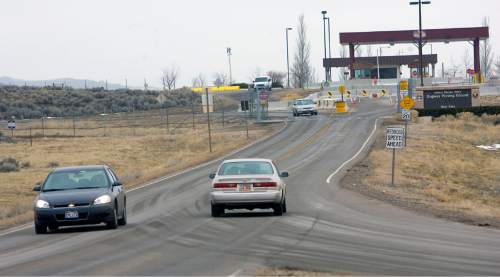This is an archived article that was published on sltrib.com in 2015, and information in the article may be outdated. It is provided only for personal research purposes and may not be reprinted.
In retrospect, Dugway Proving Ground could have done a better job detonating anthrax-laced bombs over monkeys.
It was 1955. Dugway, the U.S. Army testing center in Utah's West Desert, wanted to know how lethal anthrax could be. So anthrax was loaded into bomblets. The bomblets were dropped from an airplane in the vicinity of 285 monkeys that were brought onto Dugway.
A 2010 report by the Environmental Protection Agency raised questions about the scientific quality of the tests. (There was no discussion of the ethics.) The EPA said it didn't know the distance at which the bomblets exploded and how long the monkeys were exposed to anthrax. The Army also didn't document whether it decontaminated the monkeys after exposure.
Sixty years later, there are new questions about Dugway and anthrax. Pentagon officials last week said it appears Dugway has shipped live anthrax to dozens of labs over the years.
The anthrax was supposed to have been rendered dead. The Defense Department has said the problem appeared to be scientific or mechanical; not human error. Dugway had scheduled a media tour last week to showcase research there, but canceled it Tuesday, a day before the tour.
Whatever the mistake, it's not likely Dugway's relationship with anthrax is ending.
Desert test chamber
The U.S. military, particularly the Army, is fascinated with anthrax, either as a weapon to deploy or guard against. Part of the allure is that the bacteria cannot be spread from person to person. In nature, anthrax is transmitted through infected meat or animal skin. But anthrax can be converted into a liquid or dry form and its spores can be targeted.
"You can theoretically kill large numbers of people, but you wouldn't have something that would spread to person to person and across the earth," said Kenneth King, author of the 2010 book "Germs Gone Wild: How the Unchecked Development of Domestic Bio-Defense Threatens America."
Anthrax can cause blisters and gastrointestinal symptoms. Toxins impact the immune system and can lead to death in humans and, especially, livestock.
If you want to test biological and chemical agents without making people sick, it's tough to beat Dugway.
It's not just that Dugway is big — larger than Rhode Island — and remote. Dugway has other attributes that make it one of the closest things you can get to being a controlled environment and still be outdoors.
Dugway is relatively flat. There isn't much humidity, vegetation or insects. Scientists can predict and measure the winds there.
A study published in 2000 in MIT's Lincoln Laboratory Journal shows the kind of advantage Dugway provides. Scientists tested sensors that would alert them to an anthrax attack. Sensors tested at sites in Atlanta and Fort Leonard Wood, Mo., detected anthrax every time, but also issued one false alarm per day, the study said.
At Dugway, the tests were perfect — anthrax was detected every time with no false alarms.
The 1988 book "Gene Wars: Military Control over the New Genetic Technologies" said the first anthrax test at Dugway likely happened in 1943 when a four-pound bomb filled with anthrax was detonated. Other authors who have looked at the history of biological weapons have said the U.S. military didn't have the technology at that point. Such a test also hasn't been listed on any of the documents the Army and federal government has slowly released over the decades.
Bombing the monkeys with the disease in 1955 was supposed to tell the Army how deadly anthrax spores could be. While the tests did provide some findings, they also became the first Dugway anthrax tests to generate some questions about methods for such experiments.
According to the 2010 EPA report discussing the lethality of anthrax, it's not clear how many monkeys died in the Dugway experiment. Different reviewers examining the data came to different conclusions based on the number of spores the monkeys were exposed to.
There was no documentation of whether the monkeys were decontaminated. So spores still on the monkeys' fur could have remained there for weeks after the test.
According to Army records compiled by the Deseret News, the monkeys represented one of the seven series of open-air anthrax tests conducted at Dugway between 1954 and 1960. They were among hundreds of open-air tests of all sorts or biological and chemical weapons.
Anthrax-laced munitions like the ones dropped on the monkeys remain buried at Dugway in spots considered permanently contaminated, according to maps obtained over the years by activists and journalists.
• Offense to defense
Biological weapons testing changed forever in 1969 when President Richard Nixon ordered the military and federal government to discontinue development. Nixon had been facing pressure both because of the use of the herbicide Agent Orange in Vietnam and from the thousands of sheep found dead a year earlier in Utah's Skull Valley. Dugway had been in the midst of open-air testing of the nerve gas VX. The Army has never acknowledged that the Dugway testing was responsible, but the episode gained worldwide attention.
Anthrax testing would return to Dugway again, though in the name of defense.
In January 1991, the Army said Dugway would begin testing ways to detect and counter anthrax. The Gulf War was starting, and the Army was worried Iraq would deploy anthrax.
I. Gary Resnick, the chief of the Life Sciences Division at Dugway, told members of the Citizens Advisory Committee for Dugway Testing, that a small quantity of bacillus anthracis, the bacteria that causes anthrax, would be tested in a liquid form.
At the time, Ken Buchi sat on a the advisory committee. Buchi, a physician who has a gastroenterology practice in West Jordan, said that every time the committee or doctors would raise concerns about testing, someone from Dugway would respond that widespread contamination was unlikely.
Buchi said that wasn't what he and his colleagues worried about. They worried about a worker accidentally or unknowingly being exposed to anthrax.
"People are not infallible and mistakes will happen," Buchi said in a recent interview, "and that's really never something they were willing to acknowledge or prepare for."
• Letters in the mail
Anthrax returned to the public consciousness on Sept. 18, 2001.
That day, letters containing anthrax began arriving at the offices of U.S. senators and news outlets. The attacks killed five people and injured 17 others. A massive federal investigation began and the task force looked at whether the anthrax could have come from Dugway.
In December 2001, the Baltimore Sun was the first to report that Dugway had been making weapons grade anthrax for use in some detection and decontamination experiments. Dugway staff members were eventually ruled out as suspects, though the FBI did find discrepancies in shipping records between Dugway and the Army lab at Fort Detrick, Md. Records from the investigation make clear that the two labs sometimes lost track of the quantities of anthrax shipped.
The FBI has officially blamed former Fort Detrick anthrax scientist Bruce E. Ivins for the anthrax attack, saying he used a variant called the Ames strain that Dugway grew for him. Ivins committed suicide in 2008, shortly before the FBI announced its conclusion.
An investigation published in 2011 by news outlets Pro Publica, Frontline and McClatchy raised questions about the case against Ivins, though, quoting colleagues as saying Ivins didn't have the means to dry the liquid anthrax he received from Dugway and pointing out that the FBI wasn't able to prove Ivins mailed the letters from a mailbox near Princeton, N.J.
To King, the 2001 attacks and the most-recent errors with anthrax show the problems with what he calls the proliferation of biological weapon research. Too many people at too many laboratories have access to materials and technology, King said.
"I honestly believe our own biodefense research is a greater threat than some operative from Al-Qaeda in the mountains of Afghanistan producing it from scratch," King said.
Utahn Steve Erickson, a longtime observer of military testing and activist with the Citizens Education Project, said anthrax testing in Utah appears to be "dancing on the edge of the line between offense and defense."
The Army may be testing detection and response devices, but it also is learning how to effectively deploy anthrax, Erickson said.
Erickson hopes that in this latest anthrax scandal, Dugway and the Army are forthcoming about what went wrong.
"It's hard to get any information because there's very little oversight," Erickson said.
Twitter: @natecarlisle













